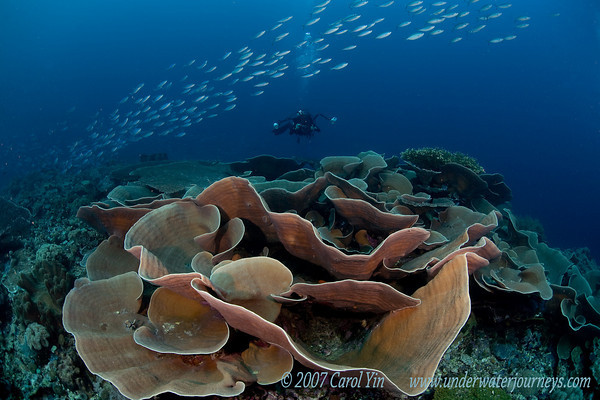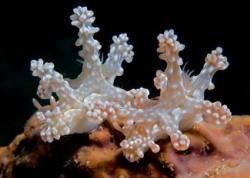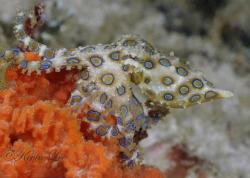Close-Focus Wide-Angle (CFWA)
Close-focus wide-angle photography underwater with ultra wide-angle lenses can be very challenging for beginners. Lighting is difficult, and photos tend to have cluttered backgrounds, no distinct subject, or the subjects are made to look very small. The best use of an ultra wide-angle lens is photographing a subject in the foreground very close to the lens. This will give your photo a great sense of depth.
CFWA shots should be done in manual mode. Your shutter speed will control the background lighting. Remember, after taking your shot, to review it, and adjust the shutter speed if needed. Make the shutter speed faster if your background is too bright, and slower if the background is too dark. Balancing the foreground and background light can seem difficult as first, but with some practise, you’ll find it’s easy. Remember – strobes control the foreground, adjust the shutter speed for the background.

Classic close-focus wide-angle shot, with a great background of schooling fish. Photo by Carol Yin, taken at Wakatobi. Canon 5D with Sigma 15mm FE, 1/160 at f7.1, ISO 125. Notes from Carol: "My camera was about 6 inches away from the edge of the corals. I like the sense of depth in this photo, due to the foreground. The diver in the photo and I were both shooting the corals, then the fish came by. I was amazed, however, that he then stopped shooting. I asked him why afterward, and he said he was waiting for the fish to get out of the picture!"
Lens Selection for CFWA underwater photography
Use as wide a lens as possible, and a fisheye lens works best such as a Tokina 10-17mm. A nikon 10.5mm + 1.4x teleconverter also works well, and gives similar results to the Tokina 10-17mm at 15mm. The new sigma 8-16mm lens is also an alternative, although it does not focus on the dome port.
Use a lens that allows very close focus.
Strobe position for CFWA underwater photography
I pull my strobes back slightly behind my dome port. The closer I am to my subject, the further in I pull my strobes, otherwise my subject is not well-lit in the center. For subjects only a few inches away, I'll need to pull my strobes all the way in, and point them in slightly.
With CFWA photographs, I find that I have a greater chance of getting hot spots in the front of my photos. Check your histograms, and raise your strobes up if necessary, and point them down slightly.
Choosing a background subject
Try to choose a good background, like deep bluewater, a boat, or a diver. If in doubt, use strong strobes like the YS-D1s and the sun.

Nikon D7000, F22, 1/250th, ISO 100, Tokina 10-17mm@10mm, dual YS-D1 strobes
CFWA Settings underwater
Settings for wide-angle are covered under wide-angle underwater photography settings. The closer the subject is to my dome port, the smaller I usually set the aperture (down to F11 or F14), to ensure enough of depth of field. Compact camera users with a wet lens will shoot at F8. Full-frame users will need to stop down (make their aperture smaller) and extra 1 1/2 stops to get equivalent depth of field. I want the background to be visible but darker than the foreground, so my shutter speed is usually between 1/125th and 1/200th of a second.
Remember -
Aperture controls depth of field, and the exposure of your foreground and background. Set this first, and then leave it.
Shutter speed - controls the exposure of your background. Adjust it until your background looks right.
Strobe power - effects the expose of your foreground subject. Use TTL or set strobe power manually.
Close-focus Wide Angle Photography Tips
Use a 10.5 or 10-17mm fisheye lens for best results (15mm on a full-frame camera), INON UCL-165 fisheye on a compact camera
I suggest getting very, very close (1-2ft away) to a prominent foreground subject (sea fan, metridium, large starfish,etc.), get very low, and shoot upwards to get a bright background. This is easier said then done, this works best if the subject is on a mound, top of a wall, or on an oil rig beam. With experience your eye will look for foreground subjects that work well.
Put an interesting background into your CFWA shot, such as a diver, boat, wreck, school of fish, or sunburst.
Position the subject not in the center, but off to the side (see the rule of thirds). If you are only using one strobe, position the object on the same side of the photo as your strobe, so you can light it with your strobe. Use a diffuser on your strobe to spread the beam out.
If you want to get the foreground and background in focus in a CFWA shot, try to focus just beyond your foreground subject.
Use your diffusers so your strobes cover a wider area
always make sure objects in the foreground are sharp and properly exposed in a CFWA shot.
CFWA shots are best taken with a small dome port like the Precision 5" Dome, so you can get low and close to your subject, and a very wide, close-focusing lens like a fisheye lens.
If you are using a dome port with your compact camera, such as a Canon G9 or G10, make sure your camera is in macro mode or your shots will be out of focus. This is because the virtual image will be very close to your dome port.
Try to shoot half of your shots in portrait style. Portrait style is not natural, but force yourself to do it on every dive.

Cuttlefish, Bali. Tokina 10-17mm lens at 17mm. D300, F13, 1/160th, ISO 200. Strobes were out to the side, pointed slightly outwards. Cuttlefish, lionfish, turtles, large seahorses, and other medium-sized marine life make excellent CFWA subjects. Try to get low and get them with blue water behind them. It was hard work getting a shot with this cuttlefish off the reef, and out of 15 shots only 1 had the cuttlefish surrounded by water, when I got down low on the rocks, a few inches in front of these feather stars.

tokina 10-17mm at 17mm, F10, 1/160th, ISO 200. I'm happy with the shot, but I probably could hae taken it at F13. The fish was a couple inches from my 8-inch dome port. I had to work hard to get low on the shot, if I had my compact dome port I could have even gotten a lower angle which I would have preferred.

This nudibranch was almost touching my dome port. I had to carefully compose and move my strobes to light the subject and diver, and also guide the diver (Keri Wilk) with hand signals - this shot took a few tries. F10, 1/125th, ISO 200, Tokina 10-17mm lens at 17mm. The right strobe, which lit the subject, was pulled in close and the power set manually.

Close-focus underwater photo of a cabezon, star of scotland wreck. Tokina 10-17mm at 17mm with a 6-inch dome port, a couple inches from the fish. Strobes were back slightly behind the housing, pointing straight ahead for even lighting. F13, ISO 400, 1/200th. I stopped down to F13 for more depth of field and sharper corners since I was getting so close. You must be very careful not to blow out the highlights on anemones like these.
More information on wide-angle photography
Complete interview on wide-angle technique underwater
Understanding dome port optics
Understanding shutter speed underwater
Lens choices for underwater photography
Sea and sea dome port tests - glass, compact and fisheye

The featherduster worm in the lower right portion of the screen is actually only 3 inches across, I was only a few inches away from it, shooting up at an extreme angle.

This squid is just inches in front of the dome port. Nice choice of background, and use of vertical lines. Photo by Todd Winner.
"Window" or "Portal shots"
A special type of CFWA photograph is the window shot. Window shots work well when a coral or structure can fill the outside of the frame, creating a "portal" that you shoot through. Shooting at the entrance to a cave, or from inside an encrusted wreck works well. Ideally you will can fish and/or a diver to appear in the portal.

My dive buddy in the oil rigs, surrounded by encrusted structure on almost all sides. This "portal" opening is actually fairly small.
Further reading

RECOMMENDED ARTICLES
SUPPORT THE UNDERWATER PHOTOGRAPHY GUIDE:
The Best Service & Prices on u/w Photo Gear
 Visit Bluewater Photo & Video for all your underwater photography and video gear. Click, or call the team at (310) 633-5052 for expert advice!
Visit Bluewater Photo & Video for all your underwater photography and video gear. Click, or call the team at (310) 633-5052 for expert advice!
The Best Pricing, Service & Expert Advice to Book your Dive Trips
 Bluewater Travel is your full-service scuba travel agency. Let our expert advisers plan and book your next dive vacation. Run by divers, for divers.
Bluewater Travel is your full-service scuba travel agency. Let our expert advisers plan and book your next dive vacation. Run by divers, for divers.































